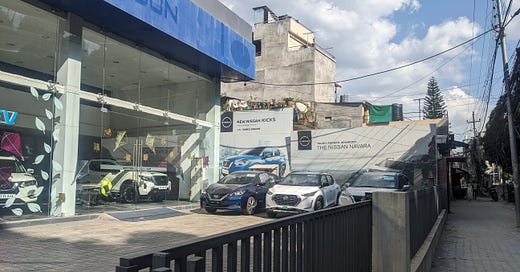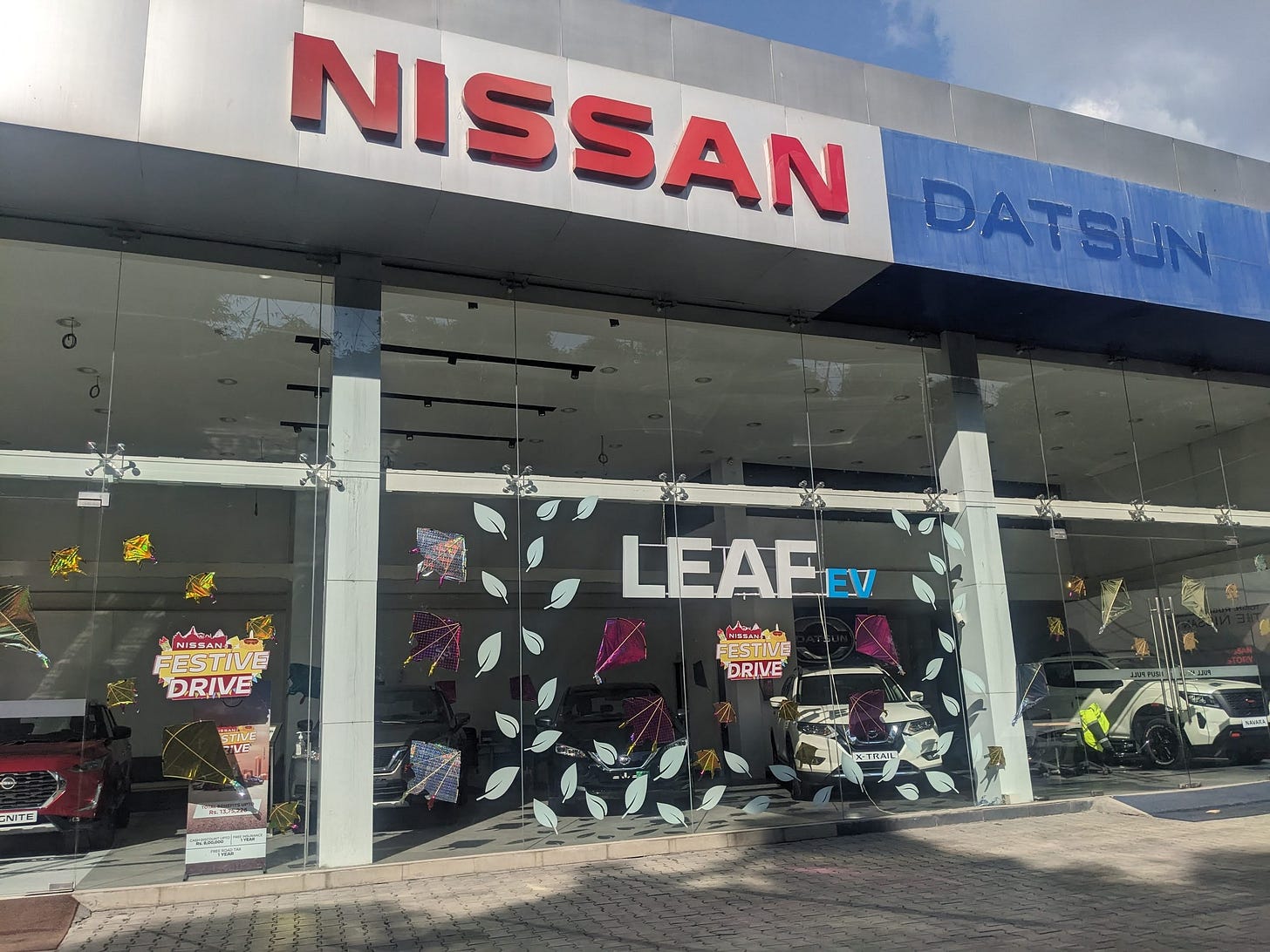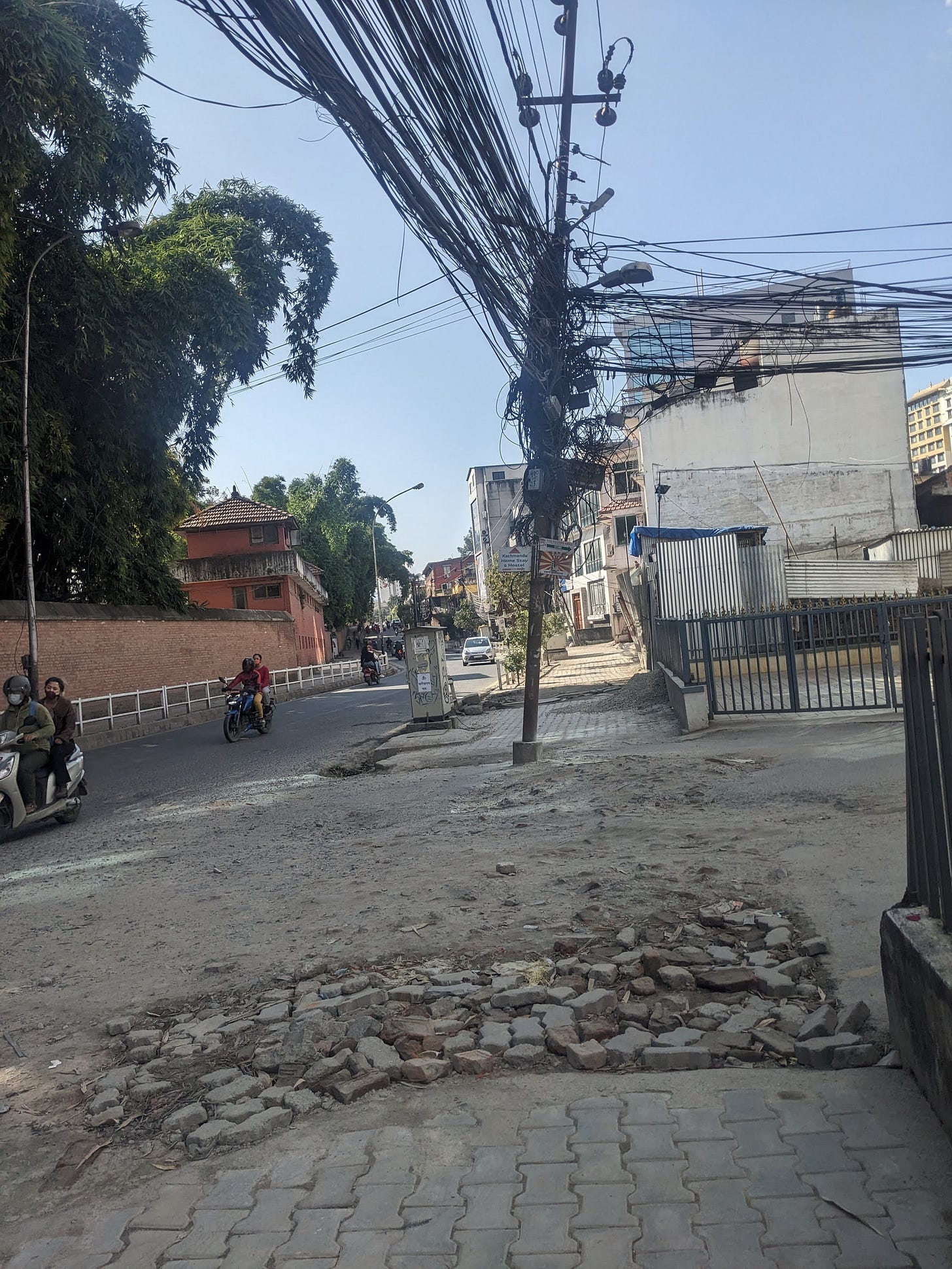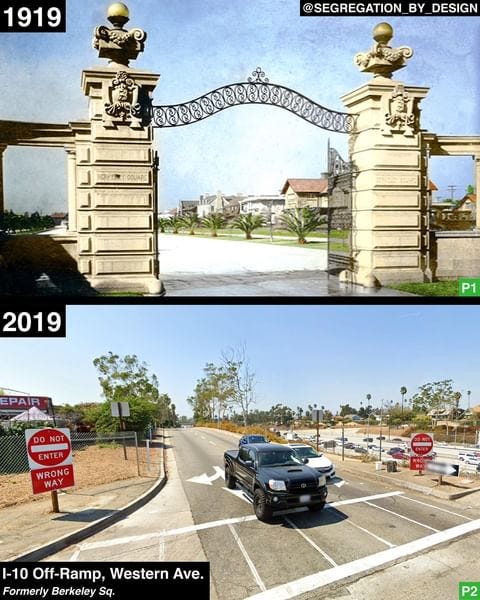America's Biggest Export: Supremacy Via Cars and Roads (Episode 7)
To the degree that a country has been affected by the USA, it has imported supremacist norms around cars and places for cars, in endlessly self-harming ways
This is part 7 of a series about land use norms different than those in the United States. The unique flavor of American land use norms has been built to accomplish ethnic cleansing, which is no more and no less than an embodied form of supremacy thinking. So, beyond just evaluating supremacy thinking within the territorial borders of the american State, I want to speak about the way American supremacist thinking flows to the rest of the world.
The USA has approximately 4.5% of the world’s population within its borders. 335 million people is ~4.5% of the ~8 billion people out there.
10% of those 335 million people are black, about 10% hispanic, and the rest of the non-white (non-European-american-immigrant-decendant) ethnic groups take up another 20%, approximately.
Therefore, about 60% of the people in America could be called ‘white’.1 That means ‘ppl who might call themselves white americans’ comprise 2.7% of the global population. or 97.3% of the world’s population seems awfully put-upon by the norms of that sorta idiosyncratic 2.7 % of the world’s population.
much more than 2.7% of the world’s money lies within that small group, of course. we could imagine some ways that money has been used to extract things from the 97%.
When traveling around the world, experiencing life a bit more from the perspective of the other 95.5%2, it’s difficult to not observe how the ‘americanized whiteness’ norms of maybe 2.7% of the world’s population has shaped the rest of the world. (That 2.7% figure comes from 4.5% * .6)
Car culture in America is inherently mixed up with supremacy and ethnic cleansing. Robert Moses was the God to those who worshiped the car. He was a supremacist, and he, along with a group of various industry, government, and private advocates and supporters, midwifed the birth of ‘car culture’ in America.
At the time of his reign of power (the 1930s through the 1960s) he won award after award after award from groups and individuals, comprising of white people, for his brilliance, ingenuity, fastidiousness, and tireless support of the public interest.
He also displaced, directly, 250,000 people of the global majority from NYC via ‘slum clearance’ programs, and in ‘eminent domain’ actions for the highways he caused to be draped across the urban fabric.
I cannot recommend reading The Power Broker: Robert Moses and the Fall of NYC enough. The conceptual compressions it’ll furnish you with will provide enormous satisfaction.
Robert Moses’ physical projects in the world were direct manifestations of how he viewed the world. They also reflect his authoritarianism and hierarchical views. I cannot help but think of Conway’s Law, which says, paraphrased:
Organizations that design systems are constrained to duplicate their own internal communication structures into those systems.
Moses viewed himself, and people like him, as unquestionably supreme. He also viewed himself as the judge of what aspects of humanity mattered, and which people groups ‘deserved’ the extension of that sense of mattering. He was so self-righteous and correct that to even question a plan of his was (to him) to oppose everything good that has ever existed.
Municipal planning departments in cities from around America, and cities from around the world, would send their staff to NYC to view the projects Moses created, to best learn how to bring those kinds of projects back to their homes.
They would learn from Moses and his staff how to “plan” projects, how to “find” financing for them, how to ‘drive stakes’ and berate and battle politicians and all opposition into submission. How to talk about the benefits their projects would bring, and how to characterize the kinds of people that opposed them. (Luddites, neanderthals, jays, ‘un-americans’, communists, opposer of progress and science and human flourishing). How to get legislative changes written and ratified that allowed road-building authorities special privileges for accessing state resources, and special exclusions from legal limits. How to hide the true costs of a project until it had already been begun.
Such was the social technology created by Robert Moses. Like any good technology, it was spreadable, copy-able, able to be built upon.
Seeing the best of American exports in Kathmandu, Nepal
America is a famously consumptive place, like any good colonial power, but it’s not without its exports.
Besides war and violence,3 America exports economic and philosophical colonialism and supremacy.
Here’s an utterly banal Nissan dealer. Can you guess what city this might be in?
In front of the dealership is a sidewalk. The sidewalk features this disastrous portion of broken pavement:
This photo is from Kathmandu, Napal, earlier today, and I couldn’t help but think of how this metaphor showed so much, about so much.
What’s the message?
Is it “Drive this car, and you can consider yourself to be tough, rugged, and advanced?”
Is it “Drive this car, and earn the right to conqueror distant mountains?”
The image is hard to see, but it’s a classic photo of a car on a rocky outcropping. Hilariously, this is an advertisement in Nepal, where definitionally, the many ethnic groups within Nepal are full of tough, rugged people firmly able to get themselves to rocky outcroppings.
Is it “Nissan is so out of touch with local conditions they will advertise blatantly tone-deaf advertisements, and your little city is so irrelevant to them that they cannot be bothered to be self-reflective about the message?”
Enough with the advertisement. Lets look at the area around the auto dealership, and examine some supremacy-laced issues with how the dealership (a colonial outpost of Nissan) integrates (or doesn’t) with the neighborhood.
The above photo is taken from right in front of the dealership. This sidewalk abuts their property line.
Cars consume enormous space4, of course, but that’s not what I wanted to capture in this photo. I wanted to capture the damage to non-car mobility infrastructure. Cars consume ‘road-use cycles’ at a breathtaking rate. That’s what is visible in the photos above. That road has been physically destroyed by being passed over by heavy vehicles, specifically, heavy turning vehicles. Lets describe quickly the physics of turning vehicles, and why it is so destructive to infrastructure intended for people.
turning tires
Have you ever gotten what is called by children the pejorative term an “Indian rug burn”? Wikipedia describes it as:
a pain-inducing prank, where the prankster grabs onto the victim's forearm or wrist, and starts turning the skin away from themselves with one hand, and with another hand towards themselves, causing an unpleasant burning sensation to the skin.
It hurts, and as I remember the experience, I remember being bullied in various institutional settings.
Anyway, a car tire turning on a piece of pavement (not simply rolling straight across) exerts a similar effect on the pavement. This effect is particularly damaging to the underlying road when the surface the tire is turning against is not directly adhered to the other portions of the surface, or the substrate.
Once the damage is started, the damage compounds, quickly. The damage isn’t just the turning - heavy vehicles going straight over the space cause a problem too. This bit of road is where cars coming out of the street from the right side of the photo are making a sharp left turn to merge with passing traffic.
In Kathmandu, as is common in the rest of Asia, driving is done on the left side of the road.
Look at the photo again:
This kind of road design is very common around the world. Tiles, pavers, bricks, cobblestones. They are easy to repair when they break, easy to install, easily placed over an undulating surface, etc. But when cars show up, they get destroyed, almost immediately.
Cars do damage to road surfaces, and where there is car culture, there are cars. Kathmandu has also been victimized by western financial institutions like the World Bank, which inevitably prioritize/direct certain kinds of infrastructure projects (road building) in order to obtain favorable interest rates on the large loans they 'give’.
A big piece of what the World Bank does is make leveraged loans to developing countries. The purpose of these loans is often “transportation projects”, which is American for “Road building projects”.
Since American road builders are supremacists, when you use American money to build americanized roads, you’re building structural supremacy into the very fabric of your country and city, with concrete and steel.
This finance piece is the second form of American car supremacy.
Supremacy (and white culture) has a few tenants it upholds, that relate to the way that money might be spent on sidewalks (for example) vs roads:
American road planners have no ability to discuss, coherently, the financial burden of installing car-appropriate infrastructure, maintaining it, repairing it, or managing it in a responsible way, especially when evaluated against the engineering case to be made for roads designed to move people on foot and motorbike.
For example, a thin road (3” asphalt + 3” gravel base) moving people on bikes, motorbikes, and their own feet can move 10-30x the vehicles/people-per-hour per meter of width that a thick road (6” of asphalt on 8” of gravel base) designed for cars can move.
American road planners do not have a conceptual framework for absorbing this piece of information.
Because the thin road is designed for small, mobile, ‘flowy’ vehicle traffic, it can also be dramatically narrower than the thick road that needs to handle large, inflexible car traffic.
A thinner and narrower road is easier to install, grade for, generates less water runoff, needs less slope erosion mitigation, requires less/no displacement of existing buildings, and leaves space physically and in the budget for adequate sidewalks. Again, American road planners (and thus the documents they shove at foreign governments) have zero conceptual framework for acknowledging the available affordances of these kinds of roads.
american road builders have access to money non-american road builders don’t
The American municipal budgeting ‘process’ is a Ponzi-scheme-like farce, but it is ‘working’ for now because the US Government can print a god-awful amount of money to fill in the budget shortfalls. The rest of the world doesn’t have this option, so by importing American road norms, and car cultures, those nations are shooting themselves in the foot, almost immediately, in pursuit of matching America’s colonialist ideals.
They’re spending money they don’t really have, on projects that will not generate a return, except encouraging a certain form of economic activity (going into debt to buy American cars), and those roads displace the kinds of activity that cities actually need:
Places to live
places to ‘hang out’ with kids, animals, nature, friends.
places to enjoy the sun in the winter and the shade in the summer. Some running water. bathrooms, water fountains. playgrounds, bike playgrounds
linear parks (long, ‘boulevard-type’ parks that connect places.) a bit more here.
huge sidewalks where people set up tables and chairs in the middle of to play boardgames
America flexes it’s might via economic and financial coercion, to ‘open markets’ in foreign countries. Lots of the time, it does this by promising streams of money to those who best perform capitalism in those countries. The assumption is always “the American Way is better than your way, Americans are better than you, and if you’re lucky, your people will become more like our people.”
Here’s some norms that get drafted along when a country’s state tries to implement American-branded urban planning ideals:
Cars are assumed to have freedom to move fast, wherever there is a road accommodating of them, drivers expect and demand priority, damned the consequences to everyone else.
State budgets are given over to roads and highways, and land-use norms warp around rushing cars from Central Business Districts (a political designation) to Residence Districts (a political designation) with stops for Economic Activity along the way (shopping, leisure).
Roads are ever-widened, squeezing out the sidewalks and places for street life on both sides
American usage of phrases like “Department of Transportation” is unchallenged, even though all the american departments of transportation cares about is roads. It would be better to call it the “Department of Personal Vehicles” or “Department of Roads” or something. But this concedes, needlessly, the fact that cars and roads can exist in a non-supremacist way, they’re just used exclusively for supremacy in America. Some countries seem to resist this energy better than others.
The phrase “free parking” implies car parking, and is a cancer to the healthy functioning of society. Wealth equals showing up in a car, or owning a car. And if you have a car, unless it’s new, or expensive, or prestigious in some way, it’ll not contribute to your social standing.
In America, cars functioned (early on, especially) as you might imagine a Roman chariot functioning. Racing through streets, frightening those who it passed, being driven by an impassive warrior-type who gazes impassively on ‘his’ domain as he goes by. It’s alienating and dangerous to experience, unless you’re the one in the car.
Modern car windows are often heavily tinted. This is dangerous for those around the vehicle, especially in lower-visiblity conditions. It’s self-protective and wise to see if the driver’s head is pointed in a way that indicates he might be aware of you. It also increases psychological distance for the driver, who further slips into a trance state of observing, but never being observed.
American movies portray cars as the default, and fast cars and fast driving as a form of the expression of power, individuality, capacity to inspire interest.
Cars promote tenants of whiteness: Individualism & Separateness, sense of urgency, Transactional relationships, Defensiveness, Progress is Better, quantity over quality, right to comfort.
Cars are heavy, relative to the people inside. It takes thousands of pounds of metal, 100 lbs+ of rubber, and 15 lbs of brake pads to move one or two people a few kilometers. On a scooter, it takes 250lbs of metal, 15 lbs of rubber, and 2 lbs of brake pads to move those same people, not even accounting the difference in gasoline consumption.
Cars relate to gasoline, obviously. So once you’ve auto-mated a city, it’s now dependent upon a hefty amount of gasoline.
Cars are flashy, and seem to naturally integrate with suckling at the teat of capitalism. Roads must be wide, and thick with many inches of asphalt, even if you’re traveling through mountainous terrain. HUGE gas stations must pepper the landscape. No one has a gas-station amount of gas at home. If you ride a scooter, it is trivial to have 10 full tanks of gas in storage at home, because even a single 5 gallon container can fill up a 1.5 gallon scooter take a few times. Obviously impossible for a car.
Cars encourage supermarkets, because you’ve got to fill the car with something. Now the front door of your house needs to accommodate it, and you probably don’t want to leave your car on the street where it could get stolen or vandalized, so like the original nomadic people sleeping in their barns with their cows, a good car-colonized culture invites their cars into their houses, to sleep with them.
Cars encourage one to dissociate from the environment. I’ve witnessed people driving cars through snow-storms in shorts and a t-shirt, because the car keeps them warm. Raining? Cold? Hot? It doesn’t matter. Close the window, turn on the AC. Cars are not Tools for Conviviality.
American culture cannot be separated from car culture. America spreads car culture around the world, with and without a region first being militarily victimized by America. Where there is car culture, there is America, and there is Robert Moses.
Robert Moses gave the world this kind of social technology:
Where there is car culture, there is supremacy culture. Consider reading About Face: Death and surrender to power in the clothing of men. Clothing (and cars) absorb how society views death, power, and surrender.
Future Episodes:
A deep dive into a chapter from The Power Broker titled “Here Come the Highway Men”. Here’s my ‘big overview’ of notes about Robert Moses: https://josh.works/robert-moses
A deep dive into two chapters from The Slaughter of Cities: Urban Renewal as Ethnic Cleansing. One about Robert Moses, the other about “The Rise of Car Culture”
I’ve spent a disproportionate amount of my life in the poorest white counties in America. Specifically, Appalachia, more specifically, Powell county. The home of the Red River Gorge, some of the best sport climbing in the world. Ditto with the New River Gorge, in the not-wealthy part of West Virginia. These counties are sometimes ranked among the poorest counties in the USA, so I understand that being White in America doesn’t mean anything about economic/cultural privilege. I simply mean whiteness is the dominant cultural perspective in America. It’s Normal, the default by which all other cultures are defined by their deviation from it.
I’m a white-passing, male, healthy, native-english-speaking, USA-passport-holding, wealthy, individual so I don’t experience the world from a position that isn’t ‘quite privileged’, but at least when I’m in, for example, Asia I can see the humanity around me living their normal lives.
Did you know the federal government of the united states operates over 700 military installations around the world? See The Sorrows of Empire: Militarism, Secrecy, and the End of the Republic for more.
Space when parked, space when moving. They quickly clog up streets, especially streets that were laid out before American Car Culture had fully colonized a space. Narrow, winding roads easily come to a grinding halt when two cars meet, passing opposite directions.









